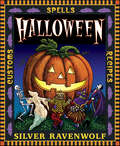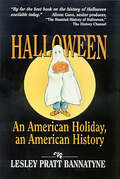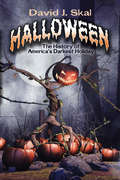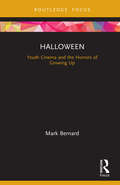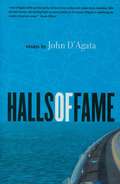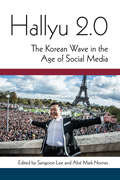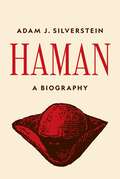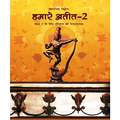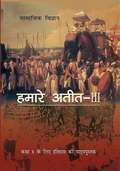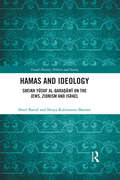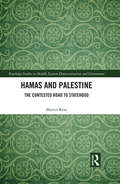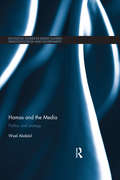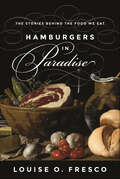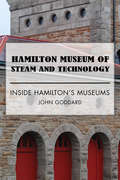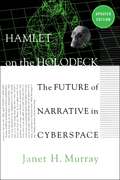- Table View
- List View
Halloween and Other Festivals of Death and Life
by Jack SantinoCollection of scholarly articles on Halloween's historical and folkloric origins, new and traditional customs and practices, and media images.
Halloween!: Customs, Recipes and Spells
by Silver RavenWolfWitches' hats and harvest moonGhosts that dance to haunted tuneApples, goodies, food galoreHalloween has this and more!Just where did the autumn gaiety begin? Let Silver RavenWolf guide you through the cobwebby corners of time to uncover the history behind Halloween. Honor the spirit of this hallowed harvest holiday with:Halloween magick: Prosperity Pumpkin Spell, Corn Husk Dolly, Solitary Harvest Moon RitualMagickal goodies: Candied Love Apples, Witches' Brew, Sugar Snakes in Graveyard DustHalloween myths and superstitions: Black cats, scarecrows, pitchforks, witches, ghosts, and haintsDivination: Circle of Ashes and Stones, Magick Mirrors, Apple, Pumpkin Seed, and Water DivinationRituals to Honor the Dead: The Dumb Supper, Samhain Fire, Soul Lights, Spirit Rattles and Spirit Bowls
Halloween: Romantic Art and Customs of Yesteryear Postcard Book
by Lesley Bannatyne"Lesley Bannatyne's fascinating book . . . will be widely appealing to anyone who ever wondered where witches, trick-or-treating, and jack-o-lanterns really came from. It is by far the best book on the history of Halloween available today."--Alison Guss, senior producer,"The Haunted History of Halloween," The History Channel"An excellent resource for research into the history of holidays . . . in the United States . . . Highly Recommended."--The Book Report"Deserves attention as a recommended library acquisition with years of 'life' to its information."--The Midwest Book Review"Overflows with rich and provocative details of ritual, feasts, superstition, and devilment."--North Carolina Historical ReviewHalloween has evolved from the Celtic celebrations of 2,000 years ago to become today the fastest-growing holiday in the country. This, the only book to completely cover All Hallow's Eve, from its beginnings to the present, examines the ancient origins as well as its traditions and celebrations, from costuming to bobbing for apples. Jack-o-lanterns, black cats, and witches are explained. Ghosts, ghouls, and goblins lurk behind every page.The book traces the contributions of America's immigrants to the holiday, documenting the beliefs each ethnic group has added to the mix. Related recipes, poems, songs, and photos perfectly complement the meticulously documented text. The result is the most educational and entertaining examination of Halloween, its myths, and its truths.
Halloween: The History of America's Darkest Holiday
by David J. SkalWonderfully well-written, outrageous, and provocative." -- Booklist."Entertaining ... and scholarly ... Like a bag of Halloween candy, the book is a lot of fun." -- Boston Globe."Fans of cultural history will devour each chapter ... like a toothsome treat." -- Christian Science Monitor.Acclaimed cultural critic David J. Skal explores one of America's most perplexingly popular holidays in this original mix of personal anecdotes and social analysis. Skal traces Halloween's evolution from its dark Celtic history and quaint, small-scale celebrations to its emergence as mammoth seasonal marketing event.Skal takes readers on a cross-country survey that covers remarkably divergent perspectives, from the merchants who welcome a money-making opportunity that's second only to Christmas to fundamentalists who decry Halloween a form of blasphemy and practicing witches who embrace it as a holy day. He also profiles individuals who revel in this once-a-year occasion to participate in elaborate fantasies. Their narratives, combined with the author's cultural analysis, offer a revealing look at an intriguing aspect of our national psyche.
Halloween: Youth Cinema and the Horrors of Growing Up (Cinema and Youth Cultures)
by Mark BernardThis book argues that Halloween need not be the first nor the most influential youth slasher film for it to hold a special place in the history of youth cinema. John Carpenter’s 1978 horror hit was once considered the be-all, end-all of teen slasher cinema and was regarded as the first, the best, and the most influential American slasher film. Recent revisions in film history, however, have challenged Halloween’s comfortable place in the canon of youth horror cinema. However, this book argues that the film, like no other, draws from the themes, imagery, and obsessions that fueled youth horror cinema since the 1950s—Gothic atmosphere, atomic dread, twisted psychology, and alienated teenage monsters—and ties them together in the deceptively simple story of a masked killer on Halloween night. Along the way, the film delivers a savage critique of social institutions and their failure to protect young people. Halloween also depicts a cadre of compelling and complicated youth characters: teenage babysitters watching over preadolescents as a killer, who is viciously avoiding the responsibilities of young adulthood, stalks them through the shadows. This book explores all these aspects of Halloween, including the franchise it spawned, providing an invaluable insight into this iconic film for students and researchers alike.
Halls of Fame: Essays
by John D'Agata"John D'Agata is an alchemist who changes trash into purest gold." —Guy Davenport, Harper'sJohn D'Agata journeys the endless corridors of America's myriad halls of fame and faithfully reports on what he finds there. In a voice all his own, he brilliantly maps his terrain in lists, collage, and ludic narratives. With topics ranging from Martha Graham to the Flat Earth Society, from the brightest light in Vegas to the artist Henry Darger, who died in obscurity, Halls of Fame hovers on the brink between prose and poetry, deep seriousness and high comedy, the subject and the self.
Hallyu 2. 0: The Korean Wave In The Age Of Social Media
by Abé Markus Nornes Sangjoon LeeCollectively known as Hallyu, Korean music, television programs, films, online games, and comics enjoy global popularity, thanks to new communication technologies. In recent years, Korean popular culture has also become the subject of academic inquiry. Whereas the Hallyu's impact on Korea's national image and domestic economy, as well as on transnational cultural flows, have received much scholarly attention, there has been little discussion of the role of social media in Hallyu's propagation. Contributors to Hallyu 2. 0: The Korean Wave in the Age of Social Media explore the ways in which Korean popular cultural products are shared by audiences around the globe; how they generate new fans, markets, and consumers through social media networks; and how scholars can analyze, interpret, and envision the future of this unprecedented cultural phenomenon.
Haman: A Biography
by Adam J. SilversteinThe first book-length study of the biblical villain Haman, examining his depiction across Judaism, Christianity, and IslamHaman, infamous as the antagonist in the book of Esther, appears as a villainous figure in virtually all varieties of Judaism, Christianity, and Islam. In this &“biography&” of Haman, Adam Silverstein traces the evolution of this villainous character from the ancient Near East to modern times, drawing on sources in a variety of languages and from diverse genres. Silverstein considers the evidence for a historical Haman and analyzes the abundance of material that documents what those who read the Bible and the Qur&’ān have thought about him over the past two millennia.With this book, Silverstein offers an essential and original account of the rich diversity and openness of Abrahamic civilizations throughout history. Taking Haman as a case study, Silverstein guides the reader through diverse intellectual terrains, covering ancient Near Eastern cultures, pre-Islamic Iranian literature, Abrahamic scriptures and their interpretation, late antiquity, Islamic history, and interfaith relations. He shows how the figure of Haman has both united and divided Jewish, Christian, and Muslim communities, who collaborated fruitfully in their efforts to grasp the meaning and significance of their holy books, but who also deployed the &“Haman&” label polemically against each other. Silverstein also considers Haman&’s prebiblical origins, raising the possibility that the book of Esther was receiving and reconfiguring Haman no less than later works were, with Esther&’s villain taking his place in a long line of reimagined Hamans.Haman: A Biography is the first book-length study to contextualize an Abrahamic character not only within Jewish and Christian traditions but also with reference to the character&’s prebiblical background and reception in Islamic cultures.
Hamara Adhbhut Sansar class 3 - NCERT: हमारा अद्भुत संसार ३रीं कक्षा - एनसीईआरटी
by Rashtriy Shaikshik Anusandhan Aur Prashikshan Parishad"हमारा अद्भुत संसार" कक्षा 3 के लिए एनसीईआरटी द्वारा विकसित एक पाठ्यपुस्तक है, जो बच्चों को उनके आस-पास की दुनिया को समझने में मदद करने के लिए तैयार की गई है। यह पुस्तक एक समग्र दृष्टिकोण अपनाती है, जिसमें बच्चों को परिवार, समुदाय, प्रकृति और पर्यावरण से संबंधित विभिन्न अवधारणाओं को सरल और रोचक तरीके से सिखाया जाता है। चार मुख्य इकाइयों में विभाजित, यह पुस्तक बच्चों को उनके परिवार और मित्रों के महत्व, मेलों और त्योहारों की सांस्कृतिक धरोहर, और प्रकृति के विविध रूपों से परिचित कराती है। पहले भाग में बच्चों को परिवार, रिश्ते, और सहयोग की भावना से अवगत कराया जाता है। दूसरे भाग में पेड़-पौधों और जानवरों के साथ हमारी निर्भरता और परस्पर संबंध को उजागर किया गया है। तीसरी इकाई में पानी, भोजन और स्वास्थ्य जैसे महत्वपूर्ण प्राकृतिक संसाधनों पर चर्चा की गई है, जबकि चौथी इकाई में वस्तुओं और उनके निर्माण की प्रक्रियाओं को समझाने पर ध्यान केंद्रित किया गया है। पुस्तक में गतिविधि-आधारित शिक्षण को बढ़ावा दिया गया है, जिससे बच्चे खेल-खेल में सीखते हैं। इसके अंतर्गत बच्चों को चित्र बनाने, सवालों के जवाब देने, और छोटे-छोटे प्रयोग करने के लिए प्रोत्साहित किया जाता है। इस पाठ्यपुस्तक का उद्देश्य बच्चों को जिज्ञासु बनाना, उन्हें उनके आसपास के पर्यावरण के प्रति संवेदनशील बनाना और उनके सीखने के अनुभव को समृद्ध करना है। "हमारा अद्भुत संसार" बच्चों को न केवल शिक्षा प्रदान करती है, बल्कि उन्हें समाज और प्रकृति के साथ गहरा संबंध स्थापित करने के लिए प्रेरित करती है।
Hamara Gaurav class 6 - JCERT: हमारा गौरव ६वीं कक्षा - जेसीईआरटी
by Jharkhand Shaikshik Anusandhan Evam Prashikshan Parishad Ranchi"हमारा गौरव" पुस्तक का उद्देश्य कक्षा 6 के छात्रों के लिए इतिहास की जानकारी प्रदान करना है। इसमें झारखंड राज्य के क्षेत्रीय परिप्रेक्ष्य को ध्यान में रखते हुए राष्ट्रीय पाठ्यचर्या की रूपरेखा 2005 (NCF-2005) के अनुरूप बाल केंद्रित गुणात्मक शिक्षा पर जोर दिया गया है। पुस्तक में विद्यार्थियों की प्रतिभा निखारने और उन्हें प्रतियोगिताओं में सफल होने के लिए आवश्यक शिक्षण सामग्री दी गई है। इसमें ऐतिहासिक घटनाओं, व्यक्तित्वों, और सांस्कृतिक विरासत का विस्तृत विवरण है, जो बच्चों को झारखंड और भारत के इतिहास से अवगत कराता है। इसके साथ ही, पुस्तक में शिक्षकों को सुझाव दिए गए हैं कि वे बच्चों की कल्पनाशक्ति को कैसे उभार सकते हैं और उनके विचारों को सही दिशा में ले जा सकते हैं। पुस्तक के माध्यम से बच्चों को स्व-अधिगम और स्वाध्याय के लिए प्रोत्साहित किया गया है और डिजिटल संसाधनों तक पहुँच के लिए QR कोड का उपयोग भी किया गया है। कुल मिलाकर, "हमारा गौरव" पुस्तक छात्रों में इतिहास के प्रति रुचि और जिज्ञासा उत्पन्न करने के लिए एक महत्वपूर्ण स्रोत है।
Hamare Ateet - III
by NcertThis book is prescribed for the student of class 8. This book is about the history of Modern India and India’s struggle for independence.
Hamare Ateet - III
by NcertThis book is prescribed for the student of class 8. This book is about the history of Modern India and India’s struggle for independence.
Hamare Ateet Bhag-1 class 6 - NCERT - 23: हमारे अतीत भाग-१ ६वीं कक्षा - एनसीईआरटी - २३
by Rashtriy Shaikshik Anusandhan Aur Prashikshan Parishadहमारे अतीत-1 कक्षा 6 के लिए इतिहास की पाठ्यपुस्तक, एन. सी. ई. आर. टी. इस पुस्तक की रचना के लिए बनाई गई पाठ्यपुस्तक निर्माण समिति के परिश्रम के लिए कृतज्ञता व्यक्त करती है। इस पुस्तक के प्रत्येक अध्याय को कई भागों में बाँटा गया है। इन भागों को पढ़ने, इस पर आपस में बातचीत करने और समझने के बाद ही अगले अध्याय की शुरुआत कीजिए। कुछ अध्यायों में कुछ परिभाषाएँ दी गई हैं। कुछ अध्यायों में स्रोत से एक अंश दिया गया है। इन्हें ध्यान से पढ़कर, इनमें दिए गए प्रश्नों पर चर्चा करो। प्रत्येक अध्याय के अंत में तुम्हें उपयोगी शब्दों की एक सूची मिलेगी। ये तुम्हें पाठ में आए महत्वपूर्ण विचारों विषयों की फिर से याद दिलाएगी। प्रत्येक अध्याय के अंत में तीन तरह के कार्यों की सूची दी गई है।
Hamare Ateet Bhag-2 class 7 - NCERT - 23: हमारे अतीत भाग-२ ७वीं कक्षा - एनसीईआरटी - २३
by Rashtriy Shaikshik Anusandhan Aur Prashikshan Parishadहमारे अतीत-2 कक्षा 7 के लिए इतिहास की पाठ्यपुस्तक, एन. सी. ई. आर. टी. इस पुस्तक की रचना के लिए बनाई गई पाठ्यपुस्तक निर्माण समिति के परिश्रम के लिए कृतज्ञता व्यक्त करती है। इस पुस्तक के प्रत्येक अध्याय को कई भागों में बाँटा गया है। इन भागों को पढ़ने, इस पर आपस में बातचीत करने और समझने के बाद ही अगले अध्याय की शुरुआत कीजिए।
Hamare Ateet Bhag-3 class 8 - NCERT - 23: हमारे अतीत भाग-३ ८वीं कक्षा - एनसीईआरटी - २३
by Rashtriy Shaikshik Anusandhan Aur Prashikshan Parishadकक्षा 8 के लिए इतिहास की पाठ्यपुस्तक, यह पुस्तक बहुत सारे इतिहासकारों, शिक्षाविदों और शिक्षकों की सामूहिक कोशिशों का फल है। इन अध्यायों के लेखन और संशोधन में कई माह लगे हैं। ये अध्याय कार्यशालाओं में हुई चर्चाओं और ई-मेल पर हुए विचारों के आदान-प्रदान से उपजे हैं। इस प्रक्रिया में प्रत्येक सदस्य ने प्रकारांतर से अपनी क्षमता के अनुरूप योगदान दिया है। बहुत सारे व्यक्तियों और संस्थानों ने इस किताब को तैयार करने में मदद दी। प्रोफेसर मुजफ्फर आलम और डॉ. कुमकुम रॉय ने इसके मसविदे पढ़े और बदलाव के लिए कई अहम सुझाव दिए। किताब में दिए गए चित्रों के लिए हमने कई संस्थाओं के संग्रहों का इस्तेमाल किया। दिल्ली शहर और 1857 की घटनाओं के बहुत सारे चित्र अल्काज़ी फ़ाउंडेशन फ़ॉर दि आर्ट्स से लिए गए हैं। ब्रिटिश राज के बारे में लिखी गयी उन्नीसवीं सदी की बहुत सारी सचित्र पुस्तकें इंडिया इंटरनैशनल सेंटर के बहुमूल्य इंडिया कलेक्शन का हिस्सा थीं।
Hamare Sansadhan class 8 - JCERT: हमारे संसाधन ८वीं कक्षा - जेसीईआरटी
by Jharkhand Shaikshik Anusandhan Evam Prashikshan Parishad Ranchiपुस्तक "हमारे संसाधन" कक्षा 8 के भूगोल विषय पर आधारित है, जिसमें संसाधनों की परिभाषा, प्रकार और उनके उपयोग पर चर्चा की गई है। इसमें प्राकृतिक संसाधनों, जैसे जल, मृदा, वनस्पति, और खनिजों का उल्लेख किया गया है, जो जीवन की मूलभूत आवश्यकताओं को पूरा करते हैं। साथ ही, मानव निर्मित संसाधनों, जैसे औद्योगिक वस्तुएं और प्रौद्योगिकी, को मानव द्वारा उत्पन्न संसाधनों के रूप में परिभाषित किया गया है। इसके अलावा, मानव संसाधन, अर्थात् शिक्षा, स्वास्थ्य और कौशल से सम्पन्न व्यक्ति, को भी एक महत्वपूर्ण संसाधन माना गया है। पुस्तक में सतत विकास और संसाधनों के संरक्षण पर जोर दिया गया है, ताकि आने वाली पीढ़ियों के लिए संसाधन सुरक्षित रह सकें।
Hamari Virasat class 7 - JCERT: हमारी विरासत ७वीं कक्षा - जेसीईआरटी
by Jharkhand Shaikshik Anusandhan Evam Prashikshan Parishad Ranchi“हमारी विरासत” कक्षा 7 के सामाजिक विज्ञान के इतिहास की पुस्तक है, जिसे झारखंड शैक्षिक अनुसंधान एवं प्रशिक्षण परिषद् राँची द्वारा प्रकाशित किया गया है। यह पुस्तक भारतीय इतिहास के मध्यकालीन समय का अध्ययन करती है, जिसमें छात्रों को लगभग एक हजार वर्षों के दौरान हुए राजनीतिक, सामाजिक, और आर्थिक परिवर्तनों से परिचित कराया जाता है। इसमें दिल्ली सल्तनत, मुगल साम्राज्य, शासक और उनके द्वारा निर्मित इमारतें, व्यापार और शिल्प, साथ ही झारखंड की संस्कृति को भी गहराई से समझाने का प्रयास किया गया है। इस पुस्तक के 10 अध्यायों में विभिन्न ऐतिहासिक घटनाओं, इमारतों, और शासन प्रणालियों का वर्णन किया गया है। छात्र इस पुस्तक के माध्यम से न केवल झारखंड बल्कि भारत के मध्यकालीन इतिहास से भी गहराई से जुड़ सकते हैं। अध्यायों में शासकों की प्रशासनिक, सामाजिक और सांस्कृतिक उपलब्धियों को भी विस्तार से समझाया गया है, जिससे छात्रों की तार्किक और विश्लेषणात्मक क्षमता का विकास हो सके। इस प्रकार, "हमारी विरासत" इतिहास की गहराई और उसकी समृद्ध धरोहर को समझने के लिए एक सशक्त और व्यापक पुस्तक है।
Hamas and Ideology: Sheikh Yūsuf al-Qaraḍāwī on the Jews, Zionism and Israel (Israeli History, Politics and Society)
by Shaul Bartal Nesya Rubinstein-ShemerSheikh Yusūf al- Qaraḍāwī is regarded as the most influential contemporary Muslim religious figure. His best-selling book, Al-Ḥalal wal-Ḥaram fi al-Islam ("The Forbidden and the Permitted in Islam") is perhaps one of the most widely read Islamic works, after the Qur’ān. The subject of jihad in Palestine is a salient feature of Qaraḍāwī’s thought and is addressed frequently in his books. His views on Israel and on the Jews shape those of many Muslims throughout the world. This book paints al- Qaraḍāwī’s portrait within the context of the subject of the struggle for Palestine and assesses why he is committed so fervently to the Palestinian course. It also sheds light on another important aspect of al-Qaradawi’s thought, namely the marked contrast between his ideas regarding the Muslim world and his views on relations with other religions and countries. Whereas al- Qaraḍāwī is considered to be a moderate in Islamic matters, his attitude toward the Jews and to Israel is one of abiding hatred and uncompromising struggle. The book aims to classify Qaraḍāwī’s thought along the axis of moderation and extremism by drawing comparisons between Qaraḍāwī’s teachings and those of other Muslim jurists. Furthermore, it compares the features of antisemitic writing with that of Qaraḍāwī in order to answer the question as to whether Qaraḍāwī’s teachings actually constitute an expression of anti-semitism. Despite the subject of jihad in Palestine being so central to Qaraḍāwī’s thought, there has not been a comprehensive and systematic academic study of this to date. The book therefore represents a major contribution to the field and will appeal to anyone studying the Israel-Palestine conflict, Islamic Studies, Jewish Studies, Terrorism and Political Violence.
Hamas and Palestine: The Contested Road to Statehood (Routledge Studies in Middle Eastern Democratization and Government)
by Martin KearHamas and Palestine: The Contested Road to Statehood analyses the Palestinian Islamist movement, Hamas, between 2005 and 2017. The book expounds how Hamas has employed a dual resistance strategy, consisting of political and armed resistance, as a mechanism to achieve, maintain, and defend its continued political viability. Hamas entered politics to transform the role of the Palestinian Authority from an administrative institution into one driving the Palestinian quest for independence. To achieve this the analysis explains how Hamas implemented a process of soft-Islamisation in Gaza. This was intended to build the institutional capacity of the Authority based on the bureaucratisation and professionalisation of key institutions, while selectively increasing the role of Islam in society. The book provides a detailed explanation of key shifts in Hamas’s political behaviour as it adapts to the vagaries and vicissitudes of governing Gaza, despite the imposition of Israel’s political and economic siege. Employing the Inclusion-Moderation theoretical framework, the book traces Hamas’s transformation from a non-state armed group into a legitimate actor in Palestinian politics. The book’s analysis also highlights the key role that Hamas’s national liberation agenda has on shifting its behaviour towards adopting more moderate and inclusive policy stances. Specifically, the analysis demonstrates how Hamas has made measurable shifts in it political behaviour towards accepting the primacy of the two-state solution, and its dealings with Israel and the Peace Process. The book provides a comprehensive assessment of Hamas’s time in government and its capacity to deal with the vicissitudes of governing. It is a valuable resource for students and researchers interested in the Israeli-Palestinian conflict and Middle East Politics.
Hamas and the Media: Politics and strategy (Routledge Studies in Middle Eastern Democratization and Government)
by Wael AbdelalThe Islamic resistance movement ‘Hamas’ is, arguably, one of the most important Palestinian organizations in recent decades. Since Hamas' establishment, it has extensively utilized media as a means of mobilization for its political and ideological agendas, and its tactics have undergone a remarkable evolution, from graffiti art to satellite broadcasting. This book presents the first systematic and historical contextualization of the development of Hamas' media strategy. It determines three key phases in Hamas’ development and explores the complex and important relationship at work between its politics and use of media. Assessing four elements of the Hamas media strategy; the media message (discourse), the media objectives, the infrastructure, and the target audience, this book tracks how Hamas grew its media infrastructure, and looks at how the idea of resistance has permeated the media discourse. Determining both tactical and strategic objectives and detailing the various layers to the target audience, it offers the first in-depth academic study of the Hamas media strategy. This book’s exploration of the key role the media plays in the Palestinian issue makes it a timely and relevant contribution to the study of the Israeli-Palestinian Conflict and a valuable resource for students, scholars and policymakers working in Middle Eastern studies.
Hamas: Politics, Charity, and Terrorism in the Service of Jihad
by Matthew Levitt Dennis RossHow does a group that operates terror cells and espouses violence become a ruling political party? How is the world to understand and respond to Hamas, the militant Islamist organization that Palestinian voters brought to power in the stunning election of January 2006? This important book provides the most fully researched assessment of Hamas ever written. Matthew Levitt, a counterterrorism expert with extensive field experience in Israel, the West Bank, and Gaza, draws aside the veil of legitimacy behind which Hamas hides. He presents concrete, detailed evidence from an extensive array of international intelligence materials, including recently declassified CIA, FBI, and Department of Homeland Security reports. Levitt demolishes the notion that Hamas' military, political, and social wings are distinct from one another and catalogues the alarming extent to which the organization's political and social welfare leaders support terror. He exposes Hamas as a unitary organization committed to a militant Islamist ideology, urges the international community to take heed, and offers well-considered ideas for countering the significant threat Hamas poses.
Hamburgers and Fries
by John T. EdgeAcclaimed food writer and cultural historian John T. Edge continues his sumptuous feast of a series on iconic American foods-with recipes included. With Fried Chicken and Apple Pie, John T. Edge launched a series of short books that celebrate American culture through the lore of our favorite foods. Now, with Hamburgers & Fries, Edge continues his quest to discover the very essence of America through the dishes we love and cherish. Across the nation, from backyard barbecues to Big Macs, Edge follows the evolution of the burger from frugal repast to deluxe treat, but always with a celebration of American brawn and freedom. He revisits Depression-era days, when most hamburgers were extended with bread crumbs, and goes on to trace the arc of the American experience that leads us to the haute burgers of today, with foie gras at their centers and selling for $50 apiece. Best of all, the acclaimed food writer gives us fifteen recipes for the best burger we've ever sunk our teeth into.
Hamburgers in Paradise: The Stories Behind the Food We Eat
by Louise O. FrescoA fascinating exploration of our past, present, and future relationship with foodFor the first time in human history, there is food in abundance throughout the world. More people than ever before are now freed of the struggle for daily survival, yet few of us are aware of how food lands on our plates. Behind every meal you eat, there is a story. Hamburgers in Paradise explains how.In this wise and passionate book, Louise Fresco takes readers on an enticing cultural journey to show how science has enabled us to overcome past scarcities—and why we have every reason to be optimistic about the future. Using hamburgers in the Garden of Eden as a metaphor for the confusion surrounding food today, she looks at everything from the dominance of supermarkets and the decrease of biodiversity to organic foods and GMOs. She casts doubt on many popular claims about sustainability, and takes issue with naïve rejections of globalization and the idealization of "true and honest" food. Fresco explores topics such as agriculture in human history, poverty and development, and surplus and obesity. She provides insightful discussions of basic foods such as bread, fish, and meat, and intertwines them with social topics like slow food and other gastronomy movements, the fear of technology and risk, food and climate change, the agricultural landscape, urban food systems, and food in art.The culmination of decades of research, Hamburgers in Paradise provides valuable insights into how our food is produced, how it is consumed, and how we can use the lessons of the past to design food systems to feed all humankind in the future.
Hamilton Museum of Steam and Technology: Inside Hamilton's Museums
by John GoddardInside Hamilton’s Museums helps to satisfy a growing curiosity about Canada’s steel capital as it evolves into a post-industrial city and cultural destination. In this special excerpt we visit Hamilton Museum of Steam and Technology, which displays the wondrous twin waterworks engines that supplied the City of Hamilton with fresh, safe drinking water. John Goddard takes us on a detailed tour of the dignified limestone building, providing fascinating historical background and insight into the waterworks.
Hamlet on the Holodeck
by Janet H. MurrayStories define how we think, the way we play, and the way we understand our lives. And just as Gutenberg made possible the stories that ushered in the Modem Era, so is the computer having a profound effect on the stories of the late 20th century. Today we are confronting the limits of books themselves -- anticipating the end of storytelling as we know it -- even as we witness the advent of a brave new world of cyberdramas. Computer technology of the late twentieth century is astonishing, thrilling, and strange, and no one is better qualified than Janet Murray to offer a breathtaking tour of how it is reshaping the stories we live by.Can we imagine a world in which Homer's Iyre and Gutenberg's press have given way to virtual reality environments like the Star Trek® holodeck? Murray sees the harbingers of such a world in the fiction of Borges and Calvino, movies like Groundhog Day, and the videogames and Web sites of the 1990s. Where is our map for this new frontier, and what can we hope to find in it? What will it be like to step into our own stories for the first time, to change our vantage point at will, to construct our own worlds or change the outcome of a compelling adventure, be it a murder mystery or a torrid romance? Taking up where Marshall McLuhan left off, Murray offers profound and provocative answers to these and other questions.She discusses the unique properties and pleasures of digital environments and connects them with the traditional satisfactions of narrative. She analyzes the state of "immersion," of participating in a text to such an extent that you literally get lost in a story and obliterate the outside world from your awareness. She dissects the titillating effect of cyber-narratives in which stories never climax and never end, because everything is morphable, and there are always infinite possibilities for the next scene. And she introduces us to enchanted landscapes populated by witty automated characters and inventive role-playing interactors, who together make up a new kind of commedia dell'arte. Equal parts daydream and how-to, Hamlet on the Holodeck is a brilliant blend of imagination and techno-wizardry that will provoke readers and guide writers for years to come.

